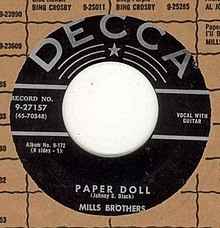Paper doll
Paper Doll is an American pop song that was composed as early as 1915, but only became a million seller in 1942 after its publication by the Mills Brothers .
History of origin
Paper Doll was created during the First World War in 1915, but only became famous during the Second World War. The author Johnny S. Black was inspired to do this after an unfortunate love affair, but initially found no interested music publisher. It was not until 1930 that the publisher Edward B Marks Music Company took pity on it and gave Black $ 50 for it. A certain Tommy Lynn took over the song for his nightclub appearances from 1930, but nobody else in the music industry seemed to be interested in it. It was not until the Mills Brothers were looking for more song repertoire in 1941 that the neglected Paper Doll was picked up again. The Mills Brothers, used to being successful, were four true African-American brothers (John, Herbert, Harry and Donald Mills) who had been making records since 1931.
The original was recorded on February 18, 1942 in just 15 minutes and only with guitar accompaniment; However, Donald Mills selected as the A-side for the single I'll Be Around . Published in April 1942 (Decca # 18318), the ballad about a man betrayed by his lover, who buys a paper doll and worships it, initially only reached 20th place on the charts. When Paper Doll finally returned to the charts on July 17, 1943 after more than a year, the single stayed at number one in the charts for 12 weeks from November 6, 1943 and # 2 in the "Harlem Hit Parade" in which it was she stayed for 29 weeks. The ballad represents the style of singing typical of the Mills Brothers: they imitate musical instruments so that the listener gets the impression of an accompanying studio band.
Million seller
By the end of September 1943, 700,000 records and over 450,000 sheet music by Paper Doll had been sold, a total of 6 million records had been sold. It was the Mills Brothers' most successful song in their 50-year recording career, during which they recorded 2,490 songs. "Anyone can take on Paper Dolls , but no one can match the successful take on the Mills Brothers," commented Billboard. Paper Doll became a war hit, because "this musical notebook dudled from every radio and every jukebox in America". The Mills Brothers would record their biggest hit three more times: in 1947, 1959 and 1974.
Fate of the composer
The eccentric Johnny S. Black had also composed Dardanella in 1920 . Born on September 30, 1891 in St. Louis , Black died very young on June 9, 1936 as a result of an unexplained brawl. As a result, he could no longer witness the success of Paper Doll and died six years before Paper Doll was published .
Most of his royalties from Paperdoll flowed to his surviving 81-year-old father. Black himself had used up all of Dardanella’s revenue and was without assets when he died. On December 8, 1943, Black's contract with the music publisher Edward B. Marks expired, causing new disputes this time over the inheritance issue.
Cover versions
Paper Doll received a BMI Award and, according to the BMI , has been covered 8 more times. Bing Crosby , Frank Sinatra (1943) and Louis Armstrong soon launched their versions, but with no particular success. Lena Horne , Perry Como (1943) and the Ink Spots also recorded the song. The discographer Tom Lord lists a total of 1 (as of 2015) cover versions in the field of jazz , u. a. also by Harry James , Glenn Miller , Hal McIntyre , Stan Kenton , Sonny Dunham , Carl Ravazza , Raymond Scott , Wingy Manone , Fred Bohler , Oscar Alemán , Eddie Barclay , Alice Babs , Louis Prima , The Four Freshmen , Si Zentner , Arne Bue Jensen and Harry Allen . Paper Doll has appeared in a few Hollywood productions, notably Hi, Good Lookin ' (1944), American Graffiti (1973), and The Majestic (2001).
Individual evidence
- ^ Jay Warner, American Singing Groups , 2006, p. 45
- ↑ Butler County Biografies, pp. 23 f.
- ^ Billboard Magazine, August 28, 1943
- ↑ Time Magazine, November 1943 issue
- ^ David A. Jasen, Tin Pan Alley: An Encyclopedia of the Golden Age of American Song 2003, p. 206
- ↑ BMI entry for Paper Doll ( page no longer available , search in web archives ) Info: The link was automatically marked as defective. Please check the link according to the instructions and then remove this notice.
- ↑ Tom Lord: Jazz discography (online)
